- Accueil
- Pages cachées
- 06 OCTOBRE 2023 NEWS
06 OCTOBRE 2023 NEWS
INSTITUT SUPERIEUR D'ANTHROPOLOGIE
INSTITUT OF ANTHROPOLOGY
COURS ONLINE – COURS A DISTANCE
INSCRIPTIONS : OCTOBRE 2023
REGISTER NOW
CHINE – 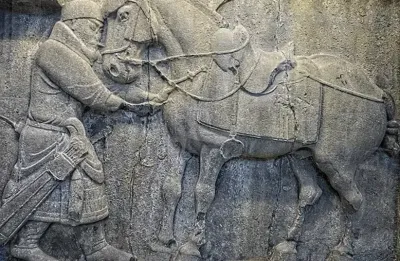 Xianyang - A tomb from 1,400 years ago uncovered near the city of Xianyang in Shaanxi province in China has proven that a power struggle occurred in the court of the Chinese emperor which was until now only mentioned in written accounts according to a Chinese report on the findings. Archeologists excavating the site found the inscription “Duke of Lueyang”, proving that at the time of his death, he was buried as a Duke and not an Emperor and he was later posthumously crowned. The tomb is one room, roughly 33 feet deep. Unfortunately, excavators found that the tomb had been ransacked at some, presumably ancient, point in time. However, 146 artifacts buried underground were found. These included terra-cotta figurines, for which the region is well known. The tomb is from a period between 420 to 589 CE, when China was split into Northern and Southern dynasties and which saw many wars and internal power struggles within the royal houses. Jue was given the throne by his cousin, Yuwen Hu, a local warlord. He himself was the son of a deceased warlord.However, Jue eventually rebelled and was deposed and executed by Hu and was replaced by a brother of JUe. The brother though, poisoned Hu and declared Jue to have been the first emperor of the Northern Dynasty, a story which had only been found in written records until the startling discovery of the tomb of this shortlived emperor.
Xianyang - A tomb from 1,400 years ago uncovered near the city of Xianyang in Shaanxi province in China has proven that a power struggle occurred in the court of the Chinese emperor which was until now only mentioned in written accounts according to a Chinese report on the findings. Archeologists excavating the site found the inscription “Duke of Lueyang”, proving that at the time of his death, he was buried as a Duke and not an Emperor and he was later posthumously crowned. The tomb is one room, roughly 33 feet deep. Unfortunately, excavators found that the tomb had been ransacked at some, presumably ancient, point in time. However, 146 artifacts buried underground were found. These included terra-cotta figurines, for which the region is well known. The tomb is from a period between 420 to 589 CE, when China was split into Northern and Southern dynasties and which saw many wars and internal power struggles within the royal houses. Jue was given the throne by his cousin, Yuwen Hu, a local warlord. He himself was the son of a deceased warlord.However, Jue eventually rebelled and was deposed and executed by Hu and was replaced by a brother of JUe. The brother though, poisoned Hu and declared Jue to have been the first emperor of the Northern Dynasty, a story which had only been found in written records until the startling discovery of the tomb of this shortlived emperor.
Discovery of emperor's tomb proves ancient power struggle in China - The Jerusalem Post (jpost.com)
KYRGYZSTAN – 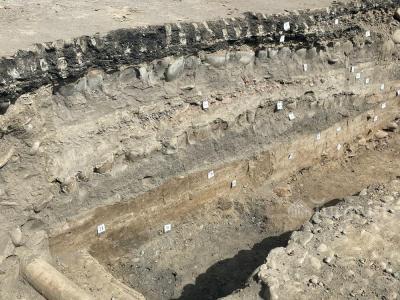 Uzgen - Archaeological work continues at the site where a road made of stones was discovered in Uzgen city.
Uzgen - Archaeological work continues at the site where a road made of stones was discovered in Uzgen city.
Ancient road made of stones discovered in Uzgen - AKIpress News Agency
JAPON – 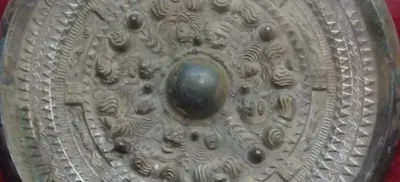 Sakurai - Archaeologists in Japan have unearthed more than 100 ancient bronze mirrors from the Sakurai Chausuyama burial mound in Sakurai, Nara Prefecture. Sakurai Chausuyama Kofun is a huge keyhole-shaped mound constructed at the beginning of the early Kofun period (250 AD–552 AD) located in Sakurai City, Nara Prefecture. It is also called Tobi Chausuyama-kofun Tumulus. This tumulus is a 207-meter-long Ekagami-shiki tumulus (hand mirror-type keyhole-shaped mound) with the hand mirror-shaped front square part located on the left bank of the Hasegawa River abutting the Iware region. The site is designated as a “historic site” by the central government. The scale of the finds indicates the occupant of the tomb wielded immense power and perhaps had royal status, archaeologists say. The finds turned up an array of mirrors, including what are known as “Himiko’s mirrors” that have a triangular rim and are adorned with images of gods and animals, according to the prefecture-run Archaeological Institute of Kashihara here. Himiko is the name of a queen in early third-century Japan, according to ancient Chinese history texts. Some of the pieces had been made in the same mold as Sankakubuchi Shinjukyo mirrors, which are engraved with Seishi Gannen (in the Japanese reading), a period name of Wei-dynasty China, meaning the first year of the Seishi era, or 240. Himiko, a female ruler of the Yamatai-koku kingdom, is said to have received 100 mirrors from the Wei dynasty in that year…. A semi-legendary figure, Himiko is curiously absent from Japanese historical records but does appear briefly in Chinese histories. Himiko was noted for being a shaman queen, unmarried, and living in a fortress where she was served by 1,000 women. According to some sources, Himiko ruled an area referred to as Yamatai, the location of which remains in dispute. The mirrors are of 14 types and comprise 26 triangular-rimmed mirrors carrying images of gods and animals, 56 China-made mirrors in 10 designs, and 21 Japan-made mirrors of three varieties. Many of them–with the majority having come from China–are large and decorated with elaborate patterns, the officials added.
Sakurai - Archaeologists in Japan have unearthed more than 100 ancient bronze mirrors from the Sakurai Chausuyama burial mound in Sakurai, Nara Prefecture. Sakurai Chausuyama Kofun is a huge keyhole-shaped mound constructed at the beginning of the early Kofun period (250 AD–552 AD) located in Sakurai City, Nara Prefecture. It is also called Tobi Chausuyama-kofun Tumulus. This tumulus is a 207-meter-long Ekagami-shiki tumulus (hand mirror-type keyhole-shaped mound) with the hand mirror-shaped front square part located on the left bank of the Hasegawa River abutting the Iware region. The site is designated as a “historic site” by the central government. The scale of the finds indicates the occupant of the tomb wielded immense power and perhaps had royal status, archaeologists say. The finds turned up an array of mirrors, including what are known as “Himiko’s mirrors” that have a triangular rim and are adorned with images of gods and animals, according to the prefecture-run Archaeological Institute of Kashihara here. Himiko is the name of a queen in early third-century Japan, according to ancient Chinese history texts. Some of the pieces had been made in the same mold as Sankakubuchi Shinjukyo mirrors, which are engraved with Seishi Gannen (in the Japanese reading), a period name of Wei-dynasty China, meaning the first year of the Seishi era, or 240. Himiko, a female ruler of the Yamatai-koku kingdom, is said to have received 100 mirrors from the Wei dynasty in that year…. A semi-legendary figure, Himiko is curiously absent from Japanese historical records but does appear briefly in Chinese histories. Himiko was noted for being a shaman queen, unmarried, and living in a fortress where she was served by 1,000 women. According to some sources, Himiko ruled an area referred to as Yamatai, the location of which remains in dispute. The mirrors are of 14 types and comprise 26 triangular-rimmed mirrors carrying images of gods and animals, 56 China-made mirrors in 10 designs, and 21 Japan-made mirrors of three varieties. Many of them–with the majority having come from China–are large and decorated with elaborate patterns, the officials added.
More than 100 bronze mirrors found at Sakurai Chausuyama burial mound in Japan - Arkeonews
ARABIE SAOUDITE -
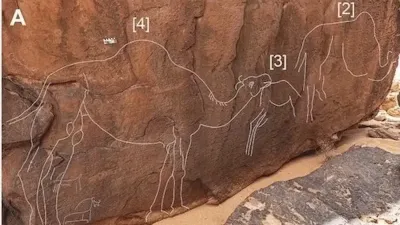
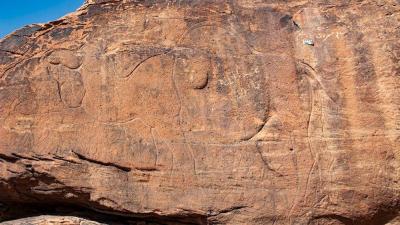 – Nafud - The Neolithic period of northern Arabia is known in part from the monumental stone structures and accompanying cave art, as well as the remains of hearths indicating temporary settlement. But there is much we do not know about the character and timing of settlement before the spread of animal pastoralism (c. 6000 BC). Researchers have recently discovered new, enigmatic carvings that shed light on this ancient history. Five panels totaling nine large life-size specimens have so far been identified. The camels have frequently had other camels carved over them or had their features and proportions improved, which suggests the site was used and visited for a very long time. The monumental artwork portrays a dozen life-size wild camels, a now-extinct species that once roamed this swath of the Arabian Peninsula desert thousands of years ago but has never received a scientific name. The art is pretty detailed, showing predominantly male camels complete with thicker winter fur that had not been molted. These details alone suggest the art may have been created during the animal’s rutting season (between November and March). This is the first time anyone has noticed the camel carvings on the outcropping, even though the site, known as Sahout, had been recognized by other archaeologists for some time. According to radiocarbon dating analysis of the two trenches and two ancient hearths found nearby, the Sahout site was repeatedly visited during what is called the late Pleistocene period (2.6 million to around 11,700 years ago) and the Middle Holocene (7,000 to 5,000 years ago). The carvings have newer etchings overlapping the camels, there’s an added layer of mystery surrounding which culture created the artwork and when. “The outcroppings contain a dense cluster of rock art from many different periods,” Guagnin said. “You can see that the carvings were done in various phases and are stylistically different.” It also doesn’t help that most of the carvings were made inside crevices, making them difficult to access and radiocarbon date.
– Nafud - The Neolithic period of northern Arabia is known in part from the monumental stone structures and accompanying cave art, as well as the remains of hearths indicating temporary settlement. But there is much we do not know about the character and timing of settlement before the spread of animal pastoralism (c. 6000 BC). Researchers have recently discovered new, enigmatic carvings that shed light on this ancient history. Five panels totaling nine large life-size specimens have so far been identified. The camels have frequently had other camels carved over them or had their features and proportions improved, which suggests the site was used and visited for a very long time. The monumental artwork portrays a dozen life-size wild camels, a now-extinct species that once roamed this swath of the Arabian Peninsula desert thousands of years ago but has never received a scientific name. The art is pretty detailed, showing predominantly male camels complete with thicker winter fur that had not been molted. These details alone suggest the art may have been created during the animal’s rutting season (between November and March). This is the first time anyone has noticed the camel carvings on the outcropping, even though the site, known as Sahout, had been recognized by other archaeologists for some time. According to radiocarbon dating analysis of the two trenches and two ancient hearths found nearby, the Sahout site was repeatedly visited during what is called the late Pleistocene period (2.6 million to around 11,700 years ago) and the Middle Holocene (7,000 to 5,000 years ago). The carvings have newer etchings overlapping the camels, there’s an added layer of mystery surrounding which culture created the artwork and when. “The outcroppings contain a dense cluster of rock art from many different periods,” Guagnin said. “You can see that the carvings were done in various phases and are stylistically different.” It also doesn’t help that most of the carvings were made inside crevices, making them difficult to access and radiocarbon date.
Mysterious and Life-size camel carvings have been found in Saudi Arabian desert - Arkeonews
ANGLETERRE –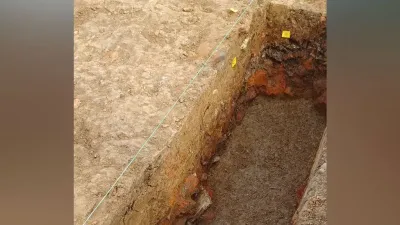
 Colchester - Roman kilns which created the bricks used to build Britain's oldest town wall have been found during a dig. The town wall was built following Boudicca's revolt and dates to about 60 to 80 AD. A Roman kiln was originally discovered at the site, which is to the south of the city's mainline railway station, in the 1960s, the director of the Colchester Archaeological Trust said. "The tenant farmer regularly ploughs up bits of red dust and broken tile and brick, so it was obvious the site was probably a tilery," he said. More than 60 trenches were dug during this summer's excavation, and Mr Crummy now believes "there might be up a dozen kilns" in the area. There would have been huge demand for clay bricks and tiles, especially during the Roman town's peak building era in the late 2nd and early 3rd centuries.
Colchester - Roman kilns which created the bricks used to build Britain's oldest town wall have been found during a dig. The town wall was built following Boudicca's revolt and dates to about 60 to 80 AD. A Roman kiln was originally discovered at the site, which is to the south of the city's mainline railway station, in the 1960s, the director of the Colchester Archaeological Trust said. "The tenant farmer regularly ploughs up bits of red dust and broken tile and brick, so it was obvious the site was probably a tilery," he said. More than 60 trenches were dug during this summer's excavation, and Mr Crummy now believes "there might be up a dozen kilns" in the area. There would have been huge demand for clay bricks and tiles, especially during the Roman town's peak building era in the late 2nd and early 3rd centuries.
Kilns used to make bricks for Colchester's Roman wall found - BBC News
EGYPTE – 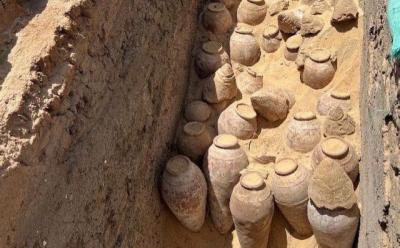 Abydos - The incredible find was from an archaeological team from Egypt, Germany and Austria who were excavating the tomb of Meret-Neith, who it is believed was an important woman from the 1st dynasty of Ancient Egypt. The jars were discovered at the Um Al-Qaab archaeological site in Abydos, Sohag Governorate, with Mostafa Waziri, secretary general of the supreme council of antiquities, stating the team found various grave goods, including hundreds of large wine jars. The jars were described as having intact stoppers and still containing ‘well-preserved’ remains of the wine. The joint Egyptian and German-Austrian team unearthed hundreds of the sealed jars containing the remains of ancient wine. Additionally, an inscription adds to evidence of Meret-Neith’s high status, it is believed.
Abydos - The incredible find was from an archaeological team from Egypt, Germany and Austria who were excavating the tomb of Meret-Neith, who it is believed was an important woman from the 1st dynasty of Ancient Egypt. The jars were discovered at the Um Al-Qaab archaeological site in Abydos, Sohag Governorate, with Mostafa Waziri, secretary general of the supreme council of antiquities, stating the team found various grave goods, including hundreds of large wine jars. The jars were described as having intact stoppers and still containing ‘well-preserved’ remains of the wine. The joint Egyptian and German-Austrian team unearthed hundreds of the sealed jars containing the remains of ancient wine. Additionally, an inscription adds to evidence of Meret-Neith’s high status, it is believed.
5000-year-old intact wine jars discovered (thedrinksbusiness.com)
INDE – 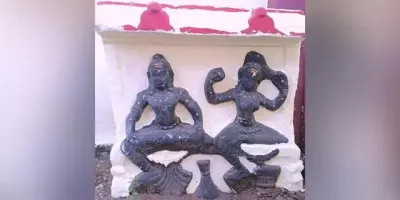 Srivilliputhur - A 550-year-old rare minstrel sati stone was found recently at Amaichiyar Amman Temple, at Madavarvalagam, in Srivilliputhur. According to sources, the sati stone is 2.5 feet high, and 3 feet wide, and was carved in granite stone. It depicts a man playing a musical instrument mridangam, along with his wife with both hands raised. Ramanathapuram Archeological Research Foundation President V Rajaguru said, "During the Sangam age, musicians were known as Panar and Padini (minstrels). Padinis were skilled in the art of dance (koothu) and in reviving the musical instrument called the lyre. The man and woman in this sculpture are designed as Panar and Padini and might have been musicians who played music, sang, and danced in the temple." He added that through the musical instruments in the sculpture, it can be known that this is the Sati stone of minstrels (Panars) who worked in the temples of Srivilliputhur. "This establishes that minstrels practiced sati. This is a rare minstrel sati stone. Based on its sculptural style, it can be considered that it belongs to the 15th century AD during Vanadirayar period," said Rajaguru, requesting the government to protect the rare sati stone. Sources said Andal temple inscriptions indicate that an order was passed to increase the number of melakars (bands of musicians playing pipe, drum, and cymbals) from 45 to 50 for temple festivals. "The minstrels were given land donations at Panankulam. They were also doing the work of sewing decorative cloths for the festival," they added.
Srivilliputhur - A 550-year-old rare minstrel sati stone was found recently at Amaichiyar Amman Temple, at Madavarvalagam, in Srivilliputhur. According to sources, the sati stone is 2.5 feet high, and 3 feet wide, and was carved in granite stone. It depicts a man playing a musical instrument mridangam, along with his wife with both hands raised. Ramanathapuram Archeological Research Foundation President V Rajaguru said, "During the Sangam age, musicians were known as Panar and Padini (minstrels). Padinis were skilled in the art of dance (koothu) and in reviving the musical instrument called the lyre. The man and woman in this sculpture are designed as Panar and Padini and might have been musicians who played music, sang, and danced in the temple." He added that through the musical instruments in the sculpture, it can be known that this is the Sati stone of minstrels (Panars) who worked in the temples of Srivilliputhur. "This establishes that minstrels practiced sati. This is a rare minstrel sati stone. Based on its sculptural style, it can be considered that it belongs to the 15th century AD during Vanadirayar period," said Rajaguru, requesting the government to protect the rare sati stone. Sources said Andal temple inscriptions indicate that an order was passed to increase the number of melakars (bands of musicians playing pipe, drum, and cymbals) from 45 to 50 for temple festivals. "The minstrels were given land donations at Panankulam. They were also doing the work of sewing decorative cloths for the festival," they added.
Rare minstrel sati stone found in Srivilliputhur- The New Indian Express
ALLEMAGNE – 
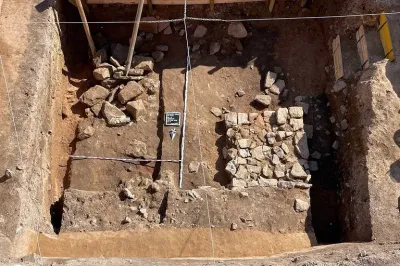 Memleben - Since 2017, archaeologists from the State Office for Monument Preservation and Archeology Saxony-Anhalt have been excavating the former imperial palace and the rich Benedictine monastery in Memleben, located in central Germany. This year’s investigations yielded new findings of extraordinary importance. For the first time, reliable archaeological evidence of the Palatinate of Memleben, the as-yet unlocated place of death of Emperor Otto the Great and his father Henry the Fowler (919-936). The site was soon turned into a monastery church by Otto’s son, Otto II. A mysterious foundation in the cloister of the monastery church can also possibly be linked to the burial of Otto the Great’s heart and internal organs. Recent research focused on three areas directly adjacent to the church built by Otto II: the area around the northeast side apse, which is partly used as a cemetery, the cloister area at the northern aisle and the connection between the side aisle and the cloister on the western transept. n 2022, the remains of the foundations of a stone structure that existed before the church was built were found directly next to the northern side apse of the monumental church of Otto II. Since this was the first indication of architecture that existed before the construction of the monumental basilica and thus dates back to the times of Henry the Fowler and Otto the Great, its study was of particular importance during this year’s excavations. The previously unknown building could be traced on a larger scale and turned out to be approximately east-west oriented. The interior is about 9.20 meters wide. The extent to the east has not yet been recorded, as the end of the building is superposed here by today’s monastery garden. In addition to clearly defined foundation pits with traces of mortared quarry stone masonry, the west side has an opening over five meters wide. A remnant of masonry in the middle of the opening suggests that it originally had two portals. The demolished remains of the building are cut by the significantly deeper foundations of the northeast apse of the monumental church. It must therefore be a building preceding the church from the 10th/11th century. Its interior has a massive rubble pavement, which served as a substructure for a lime plaster floor that is only preserved in small parts. The extraordinary quality of the building from the 10th century leads to the conclusion that it is either an older sacred building or an important, representative building of the Palatinate of Memleben. Regardless of the clarification of this question, which can be done in the future with the help of the evaluation of the skeletal material from the adjacent cemetery and further geophysical investigations, it has been possible for the first time to find archaeological evidence of the authentic place of residence and death of the rulers’ Henry and Otto.
Memleben - Since 2017, archaeologists from the State Office for Monument Preservation and Archeology Saxony-Anhalt have been excavating the former imperial palace and the rich Benedictine monastery in Memleben, located in central Germany. This year’s investigations yielded new findings of extraordinary importance. For the first time, reliable archaeological evidence of the Palatinate of Memleben, the as-yet unlocated place of death of Emperor Otto the Great and his father Henry the Fowler (919-936). The site was soon turned into a monastery church by Otto’s son, Otto II. A mysterious foundation in the cloister of the monastery church can also possibly be linked to the burial of Otto the Great’s heart and internal organs. Recent research focused on three areas directly adjacent to the church built by Otto II: the area around the northeast side apse, which is partly used as a cemetery, the cloister area at the northern aisle and the connection between the side aisle and the cloister on the western transept. n 2022, the remains of the foundations of a stone structure that existed before the church was built were found directly next to the northern side apse of the monumental church of Otto II. Since this was the first indication of architecture that existed before the construction of the monumental basilica and thus dates back to the times of Henry the Fowler and Otto the Great, its study was of particular importance during this year’s excavations. The previously unknown building could be traced on a larger scale and turned out to be approximately east-west oriented. The interior is about 9.20 meters wide. The extent to the east has not yet been recorded, as the end of the building is superposed here by today’s monastery garden. In addition to clearly defined foundation pits with traces of mortared quarry stone masonry, the west side has an opening over five meters wide. A remnant of masonry in the middle of the opening suggests that it originally had two portals. The demolished remains of the building are cut by the significantly deeper foundations of the northeast apse of the monumental church. It must therefore be a building preceding the church from the 10th/11th century. Its interior has a massive rubble pavement, which served as a substructure for a lime plaster floor that is only preserved in small parts. The extraordinary quality of the building from the 10th century leads to the conclusion that it is either an older sacred building or an important, representative building of the Palatinate of Memleben. Regardless of the clarification of this question, which can be done in the future with the help of the evaluation of the skeletal material from the adjacent cemetery and further geophysical investigations, it has been possible for the first time to find archaeological evidence of the authentic place of residence and death of the rulers’ Henry and Otto.
Archaeologists discover site where Otto the Great died - Medievalists.net
TURQUIE – 
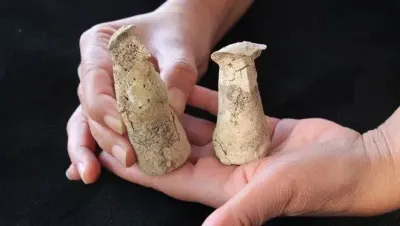 Ulucak Höyük - Prof. Dr Özlem Çevik, in northwestern Türkiye who heads the dig team, said, that in Türkiye’s Aegean province of Izmir, figurines dating back to around 5700 BC believed to represent a male-female pair and child have recently been unearthed. Saying that they came across significant findings in this year’s excavations, she explained that “the figurines were found in a space we thought was a storage area and are dated to around 5700 BC. They appear to be a female and male pair, with the female holding a baby in her lap.” She added: “Their hat-like headgear is quite different from the figurines found in Ulucak so far and has no known equivalents in Anatolia.” For those who remember the female figurine found in the Ulucak mound in 2022, this difference is quite distinctive. On the Late Neolithic layer – the oldest layer of the mound – one can see kilns and ovens, spaces reserved for daily usage as well as the sections with specific functions. In the excavations, a large number of ceramic pots, tools made of ganister, stone weapons, mother goddess figurines, and anthropomorphic pots were unearthed.
Ulucak Höyük - Prof. Dr Özlem Çevik, in northwestern Türkiye who heads the dig team, said, that in Türkiye’s Aegean province of Izmir, figurines dating back to around 5700 BC believed to represent a male-female pair and child have recently been unearthed. Saying that they came across significant findings in this year’s excavations, she explained that “the figurines were found in a space we thought was a storage area and are dated to around 5700 BC. They appear to be a female and male pair, with the female holding a baby in her lap.” She added: “Their hat-like headgear is quite different from the figurines found in Ulucak so far and has no known equivalents in Anatolia.” For those who remember the female figurine found in the Ulucak mound in 2022, this difference is quite distinctive. On the Late Neolithic layer – the oldest layer of the mound – one can see kilns and ovens, spaces reserved for daily usage as well as the sections with specific functions. In the excavations, a large number of ceramic pots, tools made of ganister, stone weapons, mother goddess figurines, and anthropomorphic pots were unearthed.
ISRAEL – 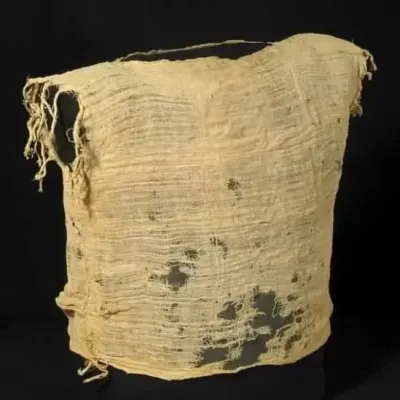 Judée - The Cave of Letters in Israel is one such site that has yielded a large number of papyrus letters and documents. It was discovered in the early 1960s CE and was excavated by the famed Israeli archaeologist Yigael Yadin from 1960-1961. Letters and papyri fragments from the Roman Empire era were discovered when the cave was examined. Some are connected to the Bar Kokhba revolt. The Cave of Letters was found above a canyon called Nahal Hever. The cave is located in the Judean desert near the Dead Sea and can only be reached by climbing 50 feet (15.24 meters) to the cave’s entrance. Archaeologists discovered a 1900-year-old child’s nightgown in the Cave of Letters, and the clothing tells a heartfelt story. Over the years, thousands of scraps of textiles dating from the Roman period have been found at different sites in Israel, but textiles with intriguing “knots” have only been uncovered in the Cave of the Letters in the Judean Desert. “The knots are like small pendants at the bottom of the garment, created by tying part of the fabric around substances known for their protective qualities: resin, salt, iron sulfate, asphalt, henna, seeds, and other unidentified materials. The binding was done by winding a flax thread around the material several times,” says Dr. Orit Shamir, Israel Antiquities Authority textile specialist.The gown had knots at the hem, and by size, belonged to a child. It was most likely used as an undergarment underneath a colorful wool upper garment for decoration. The gown is made up of two equal-sized panels sewn together along their upper edges, with an opening in the middle for the neck. The gown is adorned with flax threads hanging down from both sides of the neck. “If we examine the fabric from which the tunic was made,” says Dr. Shamir, “We’ll find that the thickness and density of the threads are not uniform. The weaving was simple, manufactured according to a simple twining technique, and occasionally mistakes were made. The sewing up of the garment is also not meticulous, and the garment has several holes, some of which resulted from wear and tear.” Since there is no doubt that the nightgown is meant for a child, it may be speculated that the knots were hung on it to protect the child from illness and harm. “You can really imagine a mother hiding salt for protection and tying up a piece of the flax garment while reciting prayers and hopes for her son or daughter,” says Dr. Shamir.
Judée - The Cave of Letters in Israel is one such site that has yielded a large number of papyrus letters and documents. It was discovered in the early 1960s CE and was excavated by the famed Israeli archaeologist Yigael Yadin from 1960-1961. Letters and papyri fragments from the Roman Empire era were discovered when the cave was examined. Some are connected to the Bar Kokhba revolt. The Cave of Letters was found above a canyon called Nahal Hever. The cave is located in the Judean desert near the Dead Sea and can only be reached by climbing 50 feet (15.24 meters) to the cave’s entrance. Archaeologists discovered a 1900-year-old child’s nightgown in the Cave of Letters, and the clothing tells a heartfelt story. Over the years, thousands of scraps of textiles dating from the Roman period have been found at different sites in Israel, but textiles with intriguing “knots” have only been uncovered in the Cave of the Letters in the Judean Desert. “The knots are like small pendants at the bottom of the garment, created by tying part of the fabric around substances known for their protective qualities: resin, salt, iron sulfate, asphalt, henna, seeds, and other unidentified materials. The binding was done by winding a flax thread around the material several times,” says Dr. Orit Shamir, Israel Antiquities Authority textile specialist.The gown had knots at the hem, and by size, belonged to a child. It was most likely used as an undergarment underneath a colorful wool upper garment for decoration. The gown is made up of two equal-sized panels sewn together along their upper edges, with an opening in the middle for the neck. The gown is adorned with flax threads hanging down from both sides of the neck. “If we examine the fabric from which the tunic was made,” says Dr. Shamir, “We’ll find that the thickness and density of the threads are not uniform. The weaving was simple, manufactured according to a simple twining technique, and occasionally mistakes were made. The sewing up of the garment is also not meticulous, and the garment has several holes, some of which resulted from wear and tear.” Since there is no doubt that the nightgown is meant for a child, it may be speculated that the knots were hung on it to protect the child from illness and harm. “You can really imagine a mother hiding salt for protection and tying up a piece of the flax garment while reciting prayers and hopes for her son or daughter,” says Dr. Shamir.